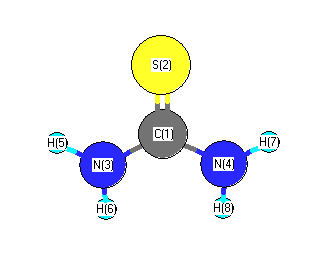Vibrational Frequencies calculated at SVWN/6-311G**
| Mode Number |
Symmetry |
Frequency
(cm-1) |
Scaled Frequency
(cm-1) |
IR Intensities
(km mol-1) |
Raman Act
(Å4/u) |
Dep P |
Dep U |
|---|
| 1 |
A |
3620 |
3582 |
25.12 |
|
|
|
| 2 |
A |
3491 |
3455 |
12.59 |
|
|
|
| 3 |
A |
1574 |
1557 |
125.08 |
|
|
|
| 4 |
A |
1388 |
1373 |
257.10 |
|
|
|
| 5 |
A |
1053 |
1042 |
25.65 |
|
|
|
| 6 |
A |
769 |
761 |
10.17 |
|
|
|
| 7 |
A |
468 |
463 |
20.39 |
|
|
|
| 8 |
A |
446 |
441 |
10.69 |
|
|
|
| 9 |
A |
301 |
297 |
113.09 |
|
|
|
| 10 |
B |
3619 |
3581 |
72.86 |
|
|
|
| 11 |
B |
3481 |
3444 |
52.12 |
|
|
|
| 12 |
B |
1570 |
1554 |
310.94 |
|
|
|
| 13 |
B |
1435 |
1420 |
14.13 |
|
|
|
| 14 |
B |
1017 |
1006 |
8.39 |
|
|
|
| 15 |
B |
622 |
615 |
6.33 |
|
|
|
| 16 |
B |
575 |
569 |
94.71 |
|
|
|
| 17 |
B |
392 |
388 |
16.72 |
|
|
|
| 18 |
B |
372 |
368 |
327.90 |
|
|
|
Unscaled Zero Point Vibrational Energy (zpe) 13095.0 cm
-1
Scaled (by 0.9896) Zero Point Vibrational Energy (zpe) 12958.8 cm
-1
See section
III.C.1 List or set vibrational scaling factors
to change the scale factors used here.
See section
III.C.2
Calculate a vibrational scaling factor for a given set of molecules
to determine the least squares best scaling factor.
Charges, Dipole, Quadrupole and Polarizability
Charges from optimized geometry at SVWN/6-311G**
Charges (e)
| Number |
Element |
Mulliken |
CHELPG |
AIM |
ESP |
| 1 |
C |
0.053 |
|
|
|
| 2 |
S |
-0.215 |
|
|
|
| 3 |
N |
-0.436 |
|
|
|
| 4 |
N |
-0.436 |
|
|
|
| 5 |
H |
0.282 |
|
|
|
| 6 |
H |
0.235 |
|
|
|
| 7 |
H |
0.282 |
|
|
|
| 8 |
H |
0.235 |
|
|
|
Electric dipole moments
Electric dipole components in Debye
(What's a Debye? See section
VII.A.3)
| |
x |
y |
z |
Total |
| |
0.000 |
0.000 |
-5.257 |
5.257 |
| CHELPG |
|
|
|
|
| AIM |
|
|
|
|
| ESP |
|
|
|
|
Electric Quadrupole moment
Quadrupole components in D Å
| Primitive |
|---|
| | x | y | z |
|---|
| x |
-34.805 |
2.092 |
0.000 |
| y |
2.092 |
-25.643 |
0.000 |
| z |
0.000 |
0.000 |
-29.105 |
|
| Traceless |
|---|
| | x | y | z |
|---|
| x |
-7.431 |
2.092 |
0.000 |
| y |
2.092 |
6.312 |
0.000 |
| z |
0.000 |
0.000 |
1.119 |
|
| Polar |
|---|
| 3z2-r2 | 2.238 |
|---|
| x2-y2 | -9.162 |
|---|
| xy | 2.092 |
|---|
| xz | 0.000 |
|---|
| yz | 0.000 |
|---|
|
Polarizabilities
Components of the polarizability tensor.
Units are
Å
3 (Angstrom cubed)
Change units.
| |
x |
y |
z |
| x |
3.254 |
0.161 |
0.000 |
| y |
0.161 |
6.768 |
0.000 |
| z |
0.000 |
0.000 |
10.082 |
<r2> (average value of r
2) Å
2
| <r2> |
0.000 |
| (<r2>)1/2 |
0.000 |
